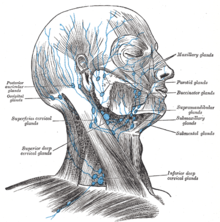User:Kenmcl2/MCL.2
| Kenmcl2/MCL.2 |
|---|
Mantle cell lymphoma (MCL) is one of the less common of the non-Hodgkin's lymphomas (NHL) at about 6% of total cases. Only about 15,000 MCL patients presently live in the U.S. There are reported to be about 3500 new cases per year. It is difficult to treat and very seldom considered to be cured. Yet investigations into better treatments are very actively being pursued worldwide. Median survival times were about 3 years, but are now estimated as approaching 6 years for new patients.
MCL is a subtype of B-cell lymphoma. It arises from a single [1] CD5 positive antigen-naïve pregerminal center B-cell within the mantle zone that surrounds normal germinal center follicles of lymph glands. MCL cells overexpress the protein named as cyclin D1, due to a t(11:14)(q13;q32) chromosomal translocation. The cause of the genetic defect is unknown and not genetic. MCL is not communicable. It essentially is an abnormal break in a gene that causes the cells to divide too early before becoming capable of helping to fight diseases. The cells also do not die as quickly as normal cells and end up expanding the lymphoid system (including nodes and spleen) with non-useful cells that render the system ultimately useless. These abnormal B-cells proliferate in a nodular or diffuse pattern with two main cytologic variants: typical or blastoid (also called as blastic). The typical variant shows small to intermediate sized cells with irregular nuclei. Blastoid variant cells are intermediate to large size with finely dispersed chromatin. The blastoid variant is notoriously more aggressive in nature.
Symptoms[edit]
Typical patients are men in their 60s and usually present with advanced disease. About half have fevers that come and go, heavy night sweats, unexplained weight loss (over 10%)or some combination of these so-called B symptoms. Women are afflicted to a much lesser degree. Adults in their 30s to 50s are also sometimes affected.

Swelling of lymph nodes and spleen are usually present. Bone marrow, liver and GI tract involvement are present in a very high percentage of cases. There can also be indigestion, abdominal pain or bloating, a feeling of “fullness” or discomfort due to an enlarged liver or spleen, pressure or pain in the lower back (often extending down one or both legs), or fatigue due to anemia.
Diagnosis[edit]
Diagnosis generally requires stained slides of a surgically removed part of a lymph node. There can be a needle aspiration biopsy of a subcutaneous node but this often yields false negatives due to insufficient sample size. Incisional or excisional biopsies are preferred.
Several methods of analyzing the biopsy material are commonly used, including Cytogenetics and Fluorescence in situ hybridization (FISH). Polymerase chain reaction (PCR), DNA treatment and CER3 clonotypic primers are additional methods that are less often used.
Causes[edit]
Attempts to determine causes of MCL have failed. It is not known what causes the translocation damage to the gene. Exposure to toxins is often mentioned as a possibility.
Prognosis[edit]
Prognosis of MCL is problematic and indexes do not work as well here due to patients normally presenting with advanced stage disease. Staging is used, but is not very informative since the cancerous B-cells normally circulate around the body through the lymphatic system anyway. Therefore, the concept of metasasis is not that relevant to lymphoproliferative disorders.
MCL is one of the few NHL’s that can cross the boundary into the brain, yet it can be treated in that event.
Treatments[edit]
There are no proven standards of treatment for MCL and no present consensus on how to treat it. Many regimens are available and often get good response rates, but patients almost always get disease progression several years after therapy. Each relapse is more difficult to treat and generally occurs faster. Fortunately, regimens are available that will treat relapse and progress is being made on that front. Because of the aforementioned factors, many MCL patients enroll in clinical trials to get the latest in treatments.
General Treatment Sequence[edit]
- First Line treatment/chemotherapy: The goal of first line therapy is to induce a remission, which is a state wherein the cancer is no longer detectable (complete remission = CR) or has decreased in extent (partial remission = PR).
- Consolidation treatment/chemotherapy: Chemotherapy is given after first complete remission in order to postpone recurrence/relapse of the cancer).
- Maintenance treatment: This is given periodically after consolidation to further postpone relapse.
- Salvage treatment/chemotherapy: These second and third line treatments are given after a patient fails to respond (or has another recurrence of disease).
